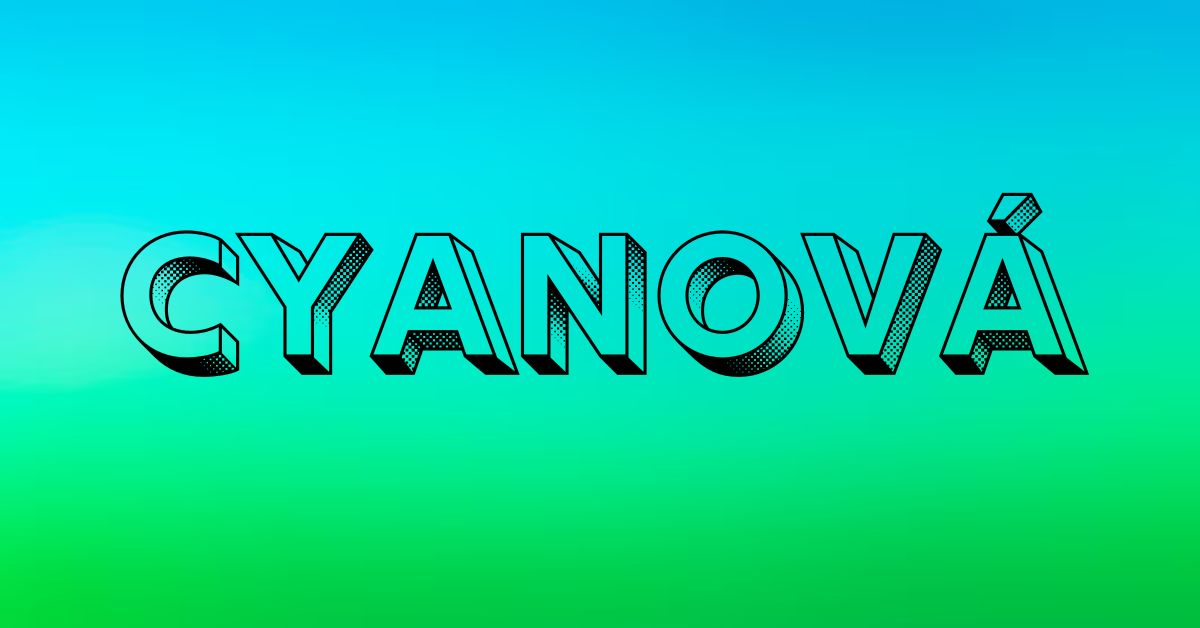General
Cyanová: The Intriguing Shade of Blue-Green

Cyanová, known in English as cyan, is a color that straddles the line between blue and green, often perceived as a unique hue in its own right. This captivating shade holds a significant place in both art and science, with its origins and applications spanning across various fields and cultures. In this article, we will delve deep into the history, etymology, significance, and usage of cyanová, offering an extensive exploration of this fascinating color.
The Etymology and Historical Origins of Cyanová
The word cyanová is derived from the ancient Greek term κύανος (kyanos), which means “dark blue” or “dark blue glaze,” and sometimes referred to the semi-precious stone lapis lazuli. The exact origin of this Greek term remains a mystery, but it is speculated to have been adopted from a non-Indo-European language, or possibly related to the Hittite word *kuwanna(n)-, meaning “copper blue.” This etymological journey reveals the deep historical roots and cultural significance of the color.
Ancient Greek Usage and Evolution
In Homeric Greek, kyanos denoted the blue of the eyes or the black of mourning garments, but it was never used to describe the color of the sky or the sea. This early usage highlights the nuanced perception of colors in ancient cultures, where specific hues were associated with particular objects or emotions rather than general natural phenomena.
During the classical Greek period, the term evolved to encompass various dark shades of blue, including those that veered towards purple, brown, and black. This broader application indicates a more sophisticated understanding of color and its variations.
From Antiquity to Modern Times
The journey of cyan from antiquity to modern times is marked by its adoption and adaptation in various cultures and scientific frameworks. The Renaissance period saw the revival of classical knowledge, including the study of colors, which laid the foundation for modern color theory. During this era, artists and scientists began to systematically explore and document colors, leading to the establishment of the primary colors in subtractive color mixing, where cyan emerged as one of the three primary colors alongside magenta and yellow in the CMYK model.
Cyanová in Art and Design
Cyanová’s unique position in the color spectrum makes it a vital component in the world of art and design. Its ability to evoke different moods and associations depending on its context has made it a favorite among artists, designers, and decorators.
The Role of Cyanová in Visual Art
Artists have long been fascinated by cyanová for its vibrant and versatile nature. It can be used to create depth, contrast, and harmony within a composition. In the context of painting, cyan is often employed to depict skies, waters, and natural landscapes, offering a serene and calming effect.
The artistic monthly Volné směry lists several synonyms for cyan, including aquamarine, blue, zinc, pike, steel (hardened), and turquoise. These variations highlight the richness and diversity of cyan, showing its different facets and applications in art.
Cyanová in Modern Design
In contemporary design, cyanová is frequently used in branding, digital media, and interior design. Its fresh and modern appeal makes it an ideal choice for creating clean, minimalist aesthetics. In graphic design, cyan is often combined with other colors to produce striking visuals that capture attention and convey specific messages.
Interior designers use cyan to bring a sense of tranquility and spaciousness to living spaces. Its cool tone is perfect for creating a relaxed and refreshing atmosphere, making it a popular choice for bedrooms, bathrooms, and other areas meant for relaxation and rejuvenation.
Cyanová in Science and Technology
Beyond its artistic and cultural significance, cyanová plays a crucial role in various scientific and technological fields. From color theory to digital imaging, this shade has a profound impact on how we perceive and interact with the world.
Cyanová in Color Theory and Printing
In the realm of color theory, cyan is one of the three primary colors in the subtractive color model, along with magenta and yellow. This model is fundamental in the printing industry, where colors are created by subtracting varying degrees of red, green, and blue light. The CMYK model (Cyan, Magenta, Yellow, Black) is the standard for color printing, allowing for the reproduction of a wide range of colors by overlapping these primary inks.
The Science of Cyan in Digital Media
In digital media, cyan is a critical component of the RGB color model (Red, Green, Blue), which is used in electronic displays such as computer monitors, televisions, and smartphones. By combining varying intensities of red, green, and blue light, digital screens can produce millions of colors, including cyan. This model is essential for creating vibrant and accurate color representations in digital images and videos.
Cyan in Nature and the Environment
Cyan is also a significant color in the natural world. It is commonly seen in bodies of water, where it results from the absorption and scattering of sunlight. The clear, turquoise waters of tropical seas and the rich blue-green hues of mountain lakes are prime examples of cyan in nature.
The Symbolism and Psychology of Cyanová
Colors have powerful psychological and symbolic meanings, and cyanová is no exception. Understanding these associations can provide deeper insights into its use and impact.
Psychological Effects of Cyan
Cyan is often associated with calmness, tranquility, and clarity. Its cool and soothing tones can have a calming effect on the mind and body, making it an ideal choice for spaces meant to promote relaxation and stress relief. This psychological impact is why cyan is frequently used in environments such as hospitals, spas, and meditation centers.
Symbolic Meanings of Cyanová
Cyanová carries various symbolic meanings across different cultures and contexts. In some cultures, it is associated with healing and protection, while in others, it represents communication and clarity. Its dual nature, bridging blue and green, also symbolizes balance and harmony.
In modern symbolism, cyan is often linked to technology and innovation, reflecting its significant role in digital media and scientific advancements. It embodies a sense of modernity and forward-thinking, making it a popular choice for tech companies and futuristic designs.
Cyanová in Popular Culture
The influence of cyanová extends into popular culture, where it appears in various forms of media and entertainment. From films and television to fashion and advertising, cyan has a prominent presence.
Cyan in Film and Television
In film and television, cyan is used to create specific atmospheres and moods. Its cool tones can evoke a sense of mystery, calm, or futuristic aesthetics. Many science fiction films and shows utilize cyan lighting and color schemes to create a sense of otherworldliness and advanced technology.
Fashion and Cyanová
In the fashion industry, cyan has made its mark as a trendy and versatile color. It appears in clothing, accessories, and makeup, offering a fresh and modern look. Designers often use cyan to create eye-catching pieces that stand out and make a statement.
Advertising and Branding
Cyanová is a popular choice in advertising and branding due to its ability to attract attention and convey modernity. Brands in the tech, healthcare, and wellness sectors frequently use cyan in their logos and marketing materials to evoke feelings of trust, innovation, and calm.
The Future of Cyanová
As we move further into the 21st century, the role and perception of cyanová continue to evolve. Advances in technology and changes in cultural trends will shape how this color is used and understood.
Innovations in Color Technology
The development of new color technologies, such as advanced digital displays and printing techniques, will expand the possibilities for using cyanová in various applications. Enhanced color accuracy and reproduction will allow for more vibrant and precise representations of cyan in digital and physical media.
Cultural and Environmental Shifts
Cultural and environmental shifts will also influence the future of cyanová. As society becomes more aware of environmental issues, the symbolic connection between cyan and nature may strengthen, leading to increased use of this color in eco-friendly designs and initiatives.
The Continued Relevance of Cyanová
Despite changes and advancements, cyanová will remain a relevant and influential color. Its unique position in the color spectrum, combined with its rich history and versatile applications, ensures that cyan will continue to captivate and inspire.
Conclusion
Cyanová, with its intriguing blend of blue and green, holds a special place in the world of colors. From its ancient Greek origins to its modern applications in art, science, and technology, cyan continues to fascinate and influence. Its calming psychological effects, symbolic meanings, and versatile uses make it a timeless and essential color. As we look to the future, cyanová will undoubtedly continue to play a significant role in shaping our visual and cultural landscape.
-

 Entertainment6 months ago
Entertainment6 months agoBaddieHub: Transforming the Landscape of Digital Empowerment
-

 Health & Fitness4 months ago
Health & Fitness4 months agoThe //vital-mag.net blog The Complete Resource for Health
-

 Review8 months ago
Review8 months agoεμφανιση σβισμενον φωτογραφιων: Restoring Deleted Photos Made Easy
-

 Review7 months ago
Review7 months agoGet in Touch with TurboGeekOrg: Maximizing Your Experience on the Ultimate Tech Platform














